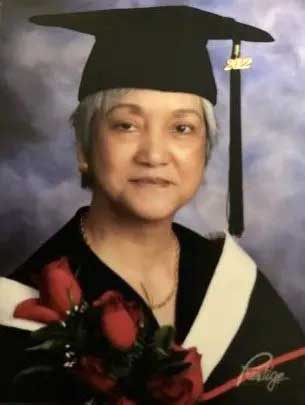Filipina grandma in Canada earns bachelor’s degree and gold medal at 73

Emma Grayda Ongsansoy achieved her dream of completing a Bachelor’s degree at the University of Winnipeg. CONTRIBUTED
WINNIPEG, Manitoba – Fifty-two years after arriving in Canada, I finally completed the journey that started when I first came to Winnipeg. The first hurdle was to get my Registered Technologist Certification that would allow me to work in Canada.
Despite graduating cum laude from a four-year program in the Philippines and being told that I only needed one year of practical training in an accredited teaching hospital, it took two years to find placement.
The schools of medical laboratory technology in Manitoba and Saskatchewan required me to take the complete 2–3-year program. I was finally accepted for practical training at the North Bay Civic Hospital in Ontario in 1972 and passed the Registered Technologist (General) examination administered by the Canadian Society for Medical Laboratory Science in 1973.
I accepted a position in the microbiology section and worked there until I moved back to Winnipeg in 1974 to work in the microbiology section of the Saint Boniface General Hospital. That’s when I started working on getting my Bachelor of Science Degree from the Philippines recognized at the University of Manitoba.
To my disappointment, I was required to take the Foreign Language (TOEFL) test and to complete 91 credit hours more of course work in order to obtain a Bachelor’s degree. I took the TOEFL just to prove my proficiency in English and obtained a total score of 672 , a score better than 99% of the candidates who took the test.
Taking two courses at the University of Manitoba, I had to put my studies on hold to raise a family while working full-time.
In 1981, I applied for admission to the University of Winnipeg Faculty of Arts and Science and surprisingly, I was only required to complete 30 credit hours for a second bachelor’s degree. However, I decided it would be more practical to get an Advanced Registered Technologist Certification in Clinical Microbiology, as I had already been taking continuing education courses and working in the field. I obtained my ART (Clinical Microbiology) in 1984.
I worked at the St. Boniface General Hospital from 1974 – 2008 and resigned my position as Charge Technologist, Quality Assurance and Media Preparation to accept an entry-level position in the Special Bacteriology Section of the National Microbiology Laboratory , a position I had coveted after completing training in Special Bacteriology at the Center for Disease Control in Atlanta in 1982. The position was not available in the Winnipeg Laboratory until 1998.
International Qualifications Assessment Service
In 2008, I decided to get my Philippine credentials re-evaluated by the International Qualifications Assessment Service (IQAS) and was assessed as comparable to the completion of Grade 12, plus a three-year Bachelor of Science Degree with a focus in medical technology. This assessment enabled me to apply for a position as Quality Officer, which required a Canadian Bachelor of Science Degree or equivalent. I held this position until my retirement in 2010.
In 2014, I decided to pursue my studies at the University of Winnipeg but changed focus from science to the humanities, by majoring in religion and culture. Tuition was free for seniors, so I decided to take one course per term to allow more time for day-to-day activities. I graduated from the University of Winnipeg with a three-year Bachelor of Arts Degree, Major in Religion and Culture. I also received a Gold Medal for Achievement in a Major. This medal is awarded at Convocation to the student with the highest overall average in the major.
I am sharing my experience to highlight an existing problem for many Filipino immigrants. Many immigrants from the Philippines are unable to get their degrees recognized in Canada. One problem is that our elementary/high school education only goes to grade 10 (to grade 11 for some). Pre-secondary education in Canada goes up to Grade 12.
The other problem is that our grading system is the opposite of the Canadian grading system. An “A” in the Philippines is equivalent to 1.0 grade point whereas in Canada, it is equivalent to 4.25 grade points. It is easy to misinterpret an “A,” with a grade point of 1.0, as equivalent to a grade of “D,” or marginal in Canada. It is therefore important to have credentials assessed by an international assessment organization. They did not have such organizations when I came to Canada in 1970.
I was lucky enough to be single when I arrived in Canada and be able to sponsor the rest of her family within one year. Going back to school when you have a family to support here or in the Philippines, is not always possible. However, it is possible to put your dreams on hold and see them fulfilled at age 73.

